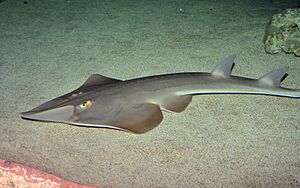Common guitarfish facts for kids
Quick facts for kids Common guitarfish |
|
|---|---|
 |
|
| Conservation status | |
| Scientific classification | |
| Genus: |
Rhinobatos
|
| Species: |
rhinobatos
|
The common guitarfish (Rhinobatos rhinobatos) is a special type of fish. It belongs to a group called cartilaginous fish, which means its skeleton is made of tough, flexible material instead of bone. This fish lives on the bottom of the ocean. You can find it in the eastern Atlantic Ocean and the Mediterranean Sea.
Common guitarfish eat crustaceans like crabs, other small sea creatures, and smaller fish. Female guitarfish give birth to live young, just like mammals. Sadly, because they live near the seabed, they are often caught by accident in fishing nets. Their numbers are going down, and they have even disappeared from some places where they used to live.
Contents
What Does the Common Guitarfish Look Like?
The common guitarfish can grow to be quite long, up to about 147 centimeters (about 58 inches). However, most of them are around 80 centimeters (about 31 inches) long. Their top side is a brownish-green color, like khaki, which helps them blend in with the seabed. Their underside is white.
This fish looks a lot like another species called the blackchin guitarfish. Both live in the same areas. However, the common guitarfish is usually smaller. It also has bigger eyes and a slightly different nose shape compared to the blackchin guitarfish.
Where Do Common Guitarfish Live?
You can find the common guitarfish in the northern Atlantic Ocean. Their range stretches from the Bay of Biscay down to Angola. They also live in the southern Mediterranean Sea.
These fish are slow swimmers. They usually cruise just above the sandy or muddy seabed. Sometimes, they will rest on the sand or mud. They might even cover themselves partly with sediment to hide.
How Do Common Guitarfish Live and Reproduce?
The common guitarfish is a benthic fish. This means it lives on or near the bottom of the ocean. It moves slowly along the sandy or muddy seabed, looking for food. Their diet includes crustaceans, other small invertebrates (animals without backbones), and smaller fish.
These fish reproduce in a special way called ovoviviparity. This means the eggs hatch inside the mother's body. The young then develop there and are born live. A female guitarfish can have one or two groups of babies each year. Each group usually has between four and ten young fish.
The babies grow inside the mother for about four months. At first, they get their food from a yolk sac, similar to a bird's egg. Later, they get more food from special liquids produced by their mother's body.
Why Are Common Guitarfish in Danger?
Common guitarfish live near the coast and have their babies in shallow water. This makes them very easy to catch. They are often caught by accident by fishing boats. This is called bycatch.
In the northern Mediterranean Sea, common guitarfish used to be caught and brought to fishing ports. But now, they are rarely seen there. They have probably disappeared from these areas, like the Balearic Islands.
Off the coast of West Africa, they are still caught. Large fishing boats that catch shrimp or cephalopods (like squid) often catch guitarfish by mistake. Local fishermen also catch them using gill nets. The meat of the guitarfish might be salted and sent to other countries. Their fins are sometimes sold to Asia.
The safest places for common guitarfish might be in the southern Mediterranean. Fishing there is not as intense. However, even there, most of the fish caught are young and not yet old enough to have babies. For these fish to survive in the long term, adult fish need to be able to grow up and reproduce.
There isn't a specific plan to protect the common guitarfish right now. Because their numbers are dropping so much, the International Union for Conservation of Nature has listed them as "critically endangered." This means they are at a very high risk of disappearing forever.


